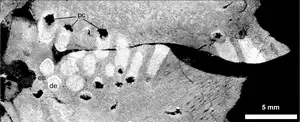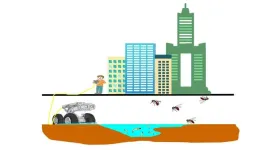(Press-News.org) (Santa Barbara, Calif.) — Wildfires. Many see them as purely destructive forces, disasters that blaze through a landscape, charring everything in their paths. But a study published in the journal Ecology Letters reminds us that wildfires are also generative forces, spurring biodiversity in their wakes.
“There’s a fair amount of biodiversity research on fire and plants,” said Max Moritz, a wildfire specialist with UC Cooperative Extension who is based at UC Santa Barbara’s Bren School of Environmental Science & Management, and is the study’s lead author. Research has shown that in ecosystems where fire is a natural and regular occurrence, there can be more species of plants — a greater “species richness” — due to a variety of factors, including fire-related adaptations. But, he said, there hasn’t been nearly as much research in the way of animal biodiversity and fire.
“If you look at how fire operates across the planet, fire actually eats plant productivity,” Moritz said. Productivity, which is a measure of how quickly biomass is generated within a given ecosystem, is also a driver of species richness at broad spatial scales. “When fires occur they can take a bite out of that bottom line,” he added.
If fire regularly consumes some of the base of an ecosystem’s food chain, how does that ripple up to affect the biodiversity at higher levels?
That was the question Moritz investigated during a project supported by UC Santa Barbara’s National Center for Ecological Analysis & Synthesis; he later recruited collaborators Enric Batllori from Universitat de Barcelona and Benjamin M. Bolker from McMaster University in Canada. For several years they combed through global datasets on various factors such as plant biomass, fire observations and species richness patterns.
While it might be natural to assume that plant biomass regularly consumed by fire would in turn lead to lower animal biodiversity, they found that for birds and mammals, fire is associated with increased diversity. In fact, they say, the effect of fire on biodiversity in the case of birds rivals that of the ecosystem’s productivity. And in the case of mammals, fire’s influence was even stronger than that of productivity.
“It’s counterintuitive,” Moritz said. In the short term, fire’s consumption of plant material (also known as “net primary productivity”) could result in less food for the animals that consume plants and make it more difficult to survive and reproduce. But in the longer term, he said, there may be evolutionary effects that unleash adaptations and formations of new species.
The researchers also looked at the effect of fire on amphibian species, however, the connection between fire and biodiversity in their case was difficult to make, possibly because amphibians live in wetter environments where fires may not be a regular occurrence.
So what accounts for the net positive effects of fire on mammal and bird diversity? The study is a correlative one, Moritz said, so more granular examinations have to be made to find out for sure. But it’s likely that fire selects for species that can adapt to and quickly recover from a burn, and fire often creates environmentally complex habitats that meet different species’ requirements.
“We know that fire creates a lot of heterogeneity and opens up all these niches,” Moritz said, and this resource availability might create favorable environments for some organisms to flourish alongside or over others. For example, animals that have strategies to survive fires or reproduce faster might do better in a fire-prone environment, as could those that make use of different habitats that emerge in the wake of a blaze.
Despite the connection between fire and species richness, the authors are careful to point out it does not mean fire is good for all ecosystems. In places where fire is not a natural occurrence, its presence “is more of a modern threat than an important process to maintain,” they said. And for places where fire is a natural part of the ecosystem, climate change-driven and intentional deforestation fires “may be quite different from natural fire regimes.”
Nevertheless, they say, these findings indicate that fire plays an underappreciated role in the generation of animal species richness and biodiversity conservation. Furthermore, the study adds nuance to the Latitudinal Biodiversity Gradient, a global pattern of terrestrial biodiversity in which the world’s most biodiverse areas are located nearest to the equator, with levels of biodiversity generally decreasing toward the poles.
“This is a pattern that people have known for decades and have argued quite a bit about in terms of what drives it,” Moritz said. “And it turns out, it’s hard to figure out. And it looks like fire plays a far more important role than we’ve ever really understood.”
END
MethaneMapper is poised to solve the problem of underreported methane emissions
2023-06-08
ELSE PRESS RELEASES FROM THIS DATE:
For pet dogs, ‘running with the pack’ may be the best prevention to promote healthier living
2023-06-08
What exactly makes for a fit Fido? And how does a dog’s environment factor into their dog years?
“People love their dogs,” said ASU School of Life Sciences assistant professor Noah Snyder-Mackler. “But what people may not know, is that this love and care, combined with their relatively shorter lifespans, make our companion dogs a great model for studying how and when aspects of the social and physical environment may alter aging, health and survival.”
Now, the largest survey and data compilation of its kind--- from more than 21,000 dog owners--- has revealed the social determinants that may be ...
New in the Hastings Center Report, May-June 2023 Issue
2023-06-08
Examining the Ethics and Impacts of Laws Restricting Transgender Youth‐Athlete Participation
Valerie Moyer, Amanda Zink, Brendan Parent
As of this writing, 21 states have passed laws barring transgender youth-athletes from competing on public school sports teams in accordance with their gender identity. Proponents of these regulations claim that transgender females in particular have inherent physiological advantages that threaten a “level playing field” for their cisgender competitors. Existing evidence is limited but does not support these restrictions. Gathering more robust ...
Geisel study offers new insights into how Medicare fraud has spread across U.S. regions in recent years
2023-06-08
Geisel Study Offers New Insights into How Medicare Fraud Has Spread Across U.S. Regions in Recent Years
Findings from an innovative study conducted by a team of researchers at Dartmouth’s Geisel School of Medicine and published in the journal Social Science & Medicine, are providing new insights into how the rapid spread (or diffusion) of fraudulent Medicare home healthcare billing has occurred across the U.S. in recent years.
To understand the significant growth of Medicare fraud during the 2000s in just a few regions of the country, the research team examined the network structure of home health agencies (HHAs) and identified a set ...
Study finds Mark Cuban’s cost plus drug company could save taxpayers millions on Medicare generic oncology drugs
2023-06-08
The U.S. government could save taxpayers between $228 million-$2.15 billion a year if insurers who operate its Medicare Part D plans purchased seven generic oncology drugs at the same prices obtained by the Mark Cuban Cost Plus Drug Company (MCCPDC), according to a study published today in the Journal of Clinical Oncology,
The Vanderbilt University Medical Center (VUMC) study, led by Ruchika Talwar, MD, a urologic oncology fellow, estimated potential savings by switching to MCCPDC prices with the implication ...
Hallucinogen use other than LSD on the rise among young adults
2023-06-08
ANN ARBOR—Young adults ages 19 to 30 nearly doubled their past 12-month use of non-LSD hallucinogens in the United States from 2018 to 2021, according to a study by the University of Michigan and Columbia University.
In 2018, the prevalence of young adults' past-year use of non-LSD hallucinogens was 3.4%. In 2021, that use increased to 6.6%.
"While non-LSD hallucinogen use remains substantially less prevalent than use of substances such as alcohol and cannabis, a doubling of prevalence in just three years is a ...
Seaweed farming may help tackle global food insecurity
2023-06-08
To help solve hunger and malnutrition while also slowing climate change, some farmers could shift from land to sea, suggests a recent study from the Friedman School of Nutrition Science and Policy at Tufts University. The study was published in Global Food Security.
Producing and selling seaweed could boost incomes for farmers in low- and middle-income countries (LMICs), particularly in coastal regions of Africa and Southeast Asia, said Patrick Webb, the Alexander McFarlane Professor of Nutrition at the Friedman School and senior author of the study. The other ...
Pritzker Molecular Engineering researchers “split” phonons – or sound – in step toward new type of quantum computer
2023-06-08
When we listen to our favorite song, what sounds like a continuous wave of music is actually transmitted as tiny packets of quantum particles called phonons.
The laws of quantum mechanics hold that quantum particles are fundamentally indivisible and therefore cannot be split, but researchers at the Pritzker School of Molecular Engineering (PME) at the University of Chicago are exploring what happens when you try to split a phonon.
In two experiments – the first of their kinds – a team led by Prof. Andrew Cleland used a device called an acoustic beamsplitter ...
Robotic vehicles fight dengue-carrying mosquitos in Taiwan sewers
2023-06-08
Unmanned ground vehicles can be used to identify and eliminate the breeding sources of mosquitos that carry dengue fever in urban areas, according to a new study published this week in PLOS Neglected Tropical Diseases by Wei-Liang Liu of the Taiwan National Mosquito-Borne Diseases Control Research Center, and colleagues.
Dengue fever is an infectious disease caused by the dengue virus and spread by several mosquito species in the genus Aedes, which also spread chikungunya, yellow fever and zika. Through the process of urbanization, ...
Reversing age-related taurine loss via supplementation improves mouse longevity and monkey health
2023-06-08
Taurine deficiency may be a driver for aging, according to a new study, which evaluated the amino acid’s effect on health and longevity across several animal models. According to the authors, reversing age-associated taurine loss via supplementation improved the healthy lifespan in worms, rodents, and non-human primates – findings that warrant further human trials to examine taurine’s effect on healthy lifespan in humans and the potential risks involved. Taurine – a semi-essential micronutrient – is one of the most abundant amino acids in animals. Previous studies in several species have shown that taurine deficiency during early life causes functional ...
2020’s COVID-19 lockdowns altered mammal movements worldwide
2023-06-08
Reduced traffic and human mobility during the 2020 COVID-19 lockdown restrictions rapidly altered some mammals’ movement behaviors, according to a new study. The findings illustrate how human activities constrain animal movement and how they react when those activities cease, which provides valuable insight into future conservation strategies designed to improve human-wildlife coexistence. During the initial global outbreak of COVID-19 in 2020, governments worldwide introduced lockdown measures to curb the spread of the virus, resulting in a drastic reduction in human mobility and vehicular traffic. This “anthropause,” as it’s come to be known, ...




